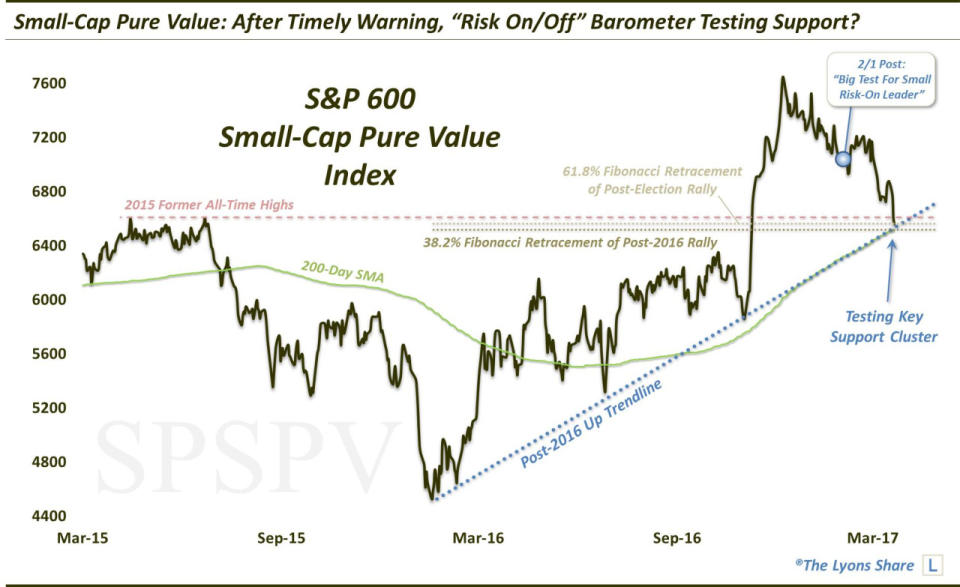After Timely Warning, Can Small Risk On/Off Leader Turn It Around?

Weakness in small-cap pure value stocks represented a well-timed red flag for stocks in early February; can the space find support nearby, or is there more “risk-off” to come?
In recent weeks we’ve detailed a series of potential “red flags” developing in the stock market. One such red flag pertained to the relative weakness in the small-cap pure value space. As we mentioned in a post in early February:
“the S&P 600 Small-Cap Pure Value Index (SPSPV) often leads the market higher during bull markets and lower during bears. A good example was a year ago when SPSPV led the market rout lower into January – and then higher in the subsequent recovery. We have found it to be the case in recent months as well.
During the post-election “Trump Rally”, the SPSPV ripped higher by 30% in just 25 days, doubling the average performance of its fellow small, mid and large-cap growth and value style brethren. However, during the 33-day consolidation since then, the index has dropped over 8%, more than double any of the other style segments. So you can see why it would be in the bulls’ best interest to have this segment of the market moving upward. And that notion makes the S&P 600 Small-Cap Pure Value’s present test of multiple support levels a potentially important factor in determining the immediate fate of the post-election rally.”
As it turns out, SPSPV did indeed hold above the aforementioned key support level near 6900 in an early to mid-February test. However, an early-March retest of that level was not successful, leading to a further plunge in the SPSPV and the further threat of a “risk-off” move in the market. Such a potential move has unfolded this week.
So is this the beginning of a much larger selloff in stocks? Looking at the current chart of the SPSPV, we see another interesting development. While we ponder whether or not the market is just beginning a larger risk-off move, the SPSPV has already reached the next level of key support on its chart, as we outlined in the February post:
“In the case of the SPSPV, that would likely take the index down to the 6400-6500 level, or 6-7% lower.”
The SPSPV hit a low yesterday of 6502.17. This vicinity boasts a plethora of key levels that may work to support the index in the immediate-term, including:
The post-January 2016 Up Trendline
The 38.2% Fibonacci Retracement of the January-December 2016 rally
The 61.8% Fibonacci Retracement of the November-December 2016 post-election rally
The 200-Day Simple Moving Average
The 2015 Previous All-Time Highs

So does the SPSPV’s arrival at this big potential support level mean that stocks’ risk-off move has likely run its course? Or has the risk simply shifted to other areas of the market?
We have yet to see anyone else in the industry recognize the Small-Cap Pure Value Index for the Risk On/Off barometer that it is. And we can pretty much guarantee you did not see anyone else identify the risk posed to this area, and the market in general, based on the breakdown in the index earlier this month. At our new “all-access” site, The Lyons Share, we address the current risk – or opportunity – in the Small-Cap Pure Value space as well as the broad stock market based on the developments outlined in this post. Of course, TLS members also receive our complete macro market analysis, including all of the noteworthy charting developments of the day – EVERY DAY. If you find the original research we share here helpful and enjoyable, we think you’ll get a ton of value from The Lyons Share.
_____________
Disclaimer: JLFMI’s actual investment decisions are based on our proprietary models. The conclusions based on the study in this letter may or may not be consistent with JLFMI’s actual investment posture at any given time. Additionally, the commentary provided here is for informational purposes only and should not be taken as a recommendation to invest in any specific securities or according to any specific methodologies. Proper due diligence should be performed before investing in any investment vehicle. There is a risk of loss involved in all investments.
